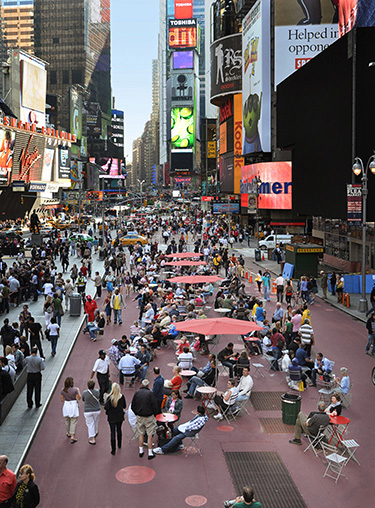|
Subscribe / Renew |
|
|
Contact Us |
|
| ► Subscribe to our Free Weekly Newsletter | |
| home | Welcome, sign in or click here to subscribe. | login |
Architecture & Engineering
| |
October 16, 2014
Urban Design Lab Oct. 23 will look at how to make people happier in cities
Journal Staff Reporter
Journalist Charles Montgomery traveled to Bogota, Colombia, in 2007 to check out the claims of Bogota's former mayor, Enrique Penalosa, that good urban design had made people happier during his three-year term.
Montgomery interviewed Penalosa as the two men biked around the city, and ever since then Montgomery has been exploring whether cities can be machines for happiness, as he puts it.
Montgomery did research and conducted informal experiments. The results are in his book “Happy City: Transforming Our Lives Through Urban Design.”
His conclusion: People are happier when they connect socially — and good urban design helps them connect.
Starting in the early 20th century, Montgomery said, modernist city planners began to separate work, schools and housing into different geographic zones.
“The result is most Americans are prisoners of dispersal,” he said. “They have no choice but to spend a significant amount of their day driving from place to place. It has made America fatter, sicker, poorer and, worst of all, socially disconnected.”
Montgomery said many planners are now starting to design walkable cities with work, housing, school and open space near each other. They are also adding networks of separated bike lanes and transit to connect these walkable hubs.
“They are trying to repair the damage done in the 20th century,” he said.

Copenhagen does a great job with mobility, he said. In the central city, most people bike to work and school because there are separated bike paths.
In New York City, former Mayor Michael Bloomberg converted some underperforming paved spaces to pedestrian plazas, parklets and bike lanes. Montgomery said businesses near those areas made more money and lease rates rose.
But even in cities trying for people-friendly urban design, there still are long stretches of dead antisocial space that can bum people out, Montgomery said.
One experiment in New York City concluded that people were less happy on blocks with big-box retail than on blocks with old tenement buildings that had small shops, cafes and activity, he said.
As more people reinhabit urban areas, cities like Seattle are “big boxing their downtowns,” he said. Montgomery said huge retailers are “colonizing” the ground floors of buildings and pushing out smaller retailers. People walk faster through or avoid these areas, and that makes those places less safe and the people less healthy, he said.
Montgomery said studies he did with Futurewise in Seattle show people feel kinder and more altruistic in lively areas than they do on blank, dead streets.
Montgomery was born in Vancouver, B.C., and raised in a small town in Canada. He has been a journalist since 1995, working at a newspaper in British Columbia and then writing for a magazine in Hong Kong.
In “Happy City,” he shares stories about cities around the world.
“If a poor city from the developing world has the wherewithal to boost happiness, surely we can do it too,” he said.
| Urban Design Lab here on Oct. 23 |
|
Urban Design Lab is set for 5 p.m. Oct. 23 in Paccar Pavillion at Olympic Sculpture Park in Seattle.
Attendees will participate in experiments conducted by Futurewise and Charles Montgomery to demonstrate how design can make people happier in urban settings. Results will be published at HappySeattle.org. Montgomery also will talk about how to improve urban design in Seattle. Similar Urban Design Lab experiments have been done in Vancouver, B.C., and New York City. Tickets are $25, or $10 for students, at http://happyseattle.org or by calling (206) 343-0681. |
The DJC asked Montgomery about his work. Here is what he said:
What motivated you to study this?
On the bike ride through Bogota with ex-Mayor Enrique Penalosa, I talked with him about his claims of transforming the city by pouring resources into infrastructure for people, rather than just cars. He canceled plans for a $6 billion network of freeways, and instead built schools, day care centers, libraries and parks in the poorest parts of the city. He took the best road space and devoted it to a rapid bus network so that poor people could cross the city as quickly as the rich in their cars.
These changes were impressive, but as a journalist, I was skeptical. Did they really make people happier? Where was the evidence? I have spent the better part of a decade looking into science, psychology and urban experiments around the world to see if the city really can be a machine for happiness.
Who did you talk with?
I looked to neuroscientists, psychologists, behavioral economists and public health experts to determine how design influences how we feel, move and treat other people.
How does urban design influence happiness?
The most powerful ingredient of human happiness is not money, status, sex or ephemeral pleasures like ice cream. It is sociability. The better our relationships with family, friends, neighbors and even strangers, the happier we are. So if we care about human happiness we need to design cities that give us more time with family and friends. We need to design spaces and systems that enable more trust-building encounters between strangers.
How does this translate into design? Well, the very worst thing for urban happiness is a long, solo, car commute. So we need to create more neighborhoods where home, school, work and play can be reached by a short walk, bike ride or on fast, high-status transit.
What's an urban design lab?
At an urban lab event like the one we are holding with Futurewise on Oct. 23, we stage participatory experiments that give people a visceral understanding of the relationship between design, social trust and their own happiness. We simulate bad transit experiences, and spontaneous encounters between strangers, for example. The experiments are immersive and fun, but they also produce data that can drive discussion about how we need to change our cities. Of course, we need to keep the experiment details secret so we don't bias our results!
What should we do next?
We need to build places and systems that nurture the social life of the city.
If our research is correct, then we need to zone to ensure that commercial streets are lined with more small shops and services rather than big-box outlets.
We need to build more gentle density into inner suburbs: more townhouses, more legal suites in single-family neighborhoods, more low-rise, mixed-use buildings along main streets.
We need to give special status to pedestrians and people who are willing to use less space on our roads. That means dedicated lanes for transit, and complete networks of safe, separated, bike routes. It also means a 20 mph speed limit on all local streets.
We need to stop subsidizing the sprawl that is making life difficult and unhealthy for everyone. That means getting the federal government to invest gas tax dollars in great transit, rather than more urban highways.
Lynn Porter can be
reached by email or by phone
at (206) 622-8272.



